

DUST COLLECTION SYSTEM WORKING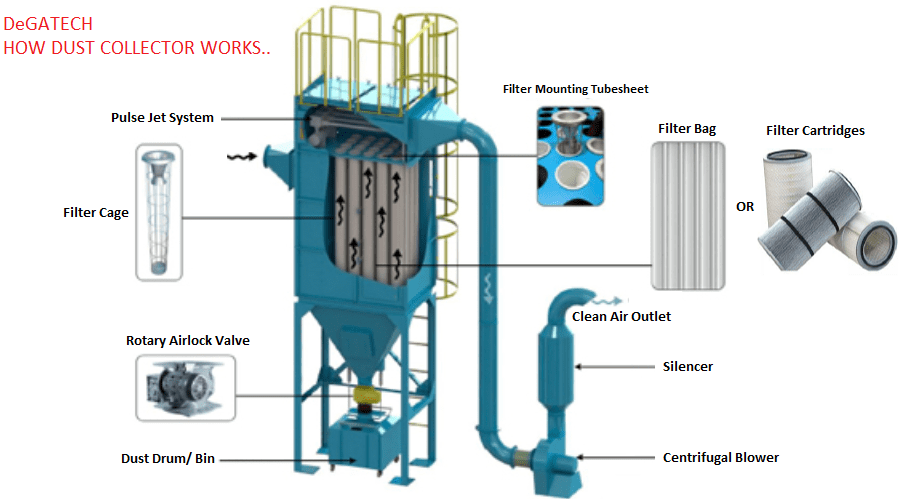
PULSE JET TYPE DUST COLLECTORS
Pulse Jet Dust Collectors are another kind of baghouse system that comes in a variety of designs to meet the application needs of the industry. The bag cleaning system operates via a rapid, high-pressure air jet cleaning which sends a blast or shock of air through the bag that shatters and discharges the dust cake for disposal. The rapid pulse of air allows for continuous operation with the fan running, and because of it the system is not generally compartmentalized. Pulse jet models are the most common type of industrial dust collectors, due to their ability to be easily customized, capability to handle a wide range of temperatures and pressures, and their high collection efficiency. They can be found in most manufacturing environments wherein bulk solids are processed, including chemical and mineral production, food processing plants and metal fabrication. Pulse jet collectors can be fabricated from a wide range of materials, including carbon steel, stainless steel, aluminum and other special alloys.

CARTRIDGE TYPE COLLECTORS
For certain applications, Cartridge dust Collectors are a type of fabric filter designed for specific applications. They offer an advantage where smaller space requirements are necessary for the same airflow of a larger baghouse system. Cartridge collectors pack more fabric area into a smaller space, utilize fewer filters, and filters can be changed from outside the collector, which minimizes safety hazards. These features also reduce the time to change the filters and associated labor costs. Find cartridge collectors in commercial and industrial environments with very fine-to-light dust and moderate dust-like powder coating, metalworking, woodworking, fume collection, thermal spray, pharmaceutical manufacturing, among other processes.
CYCLONE TYPE DUST COLLECTORS
Cyclone Dust Collectors are a type of inertial separator that separates dust from a gas stream through centrifugal force. Air is purified by creating a cyclonic action within the cyclone collection chamber. An intense circular airflow resembling a vortex pushes the dust particles against the wall of the cyclone, which slide down to the base of the hopper for collection. Cyclone systems can remove heavier and oversized particles that mix in with fine dust. They are often used as pre-cleaners before baghouses. Cyclones are often used in woodworking, pulp and paper, shot blasting, mills, grain and agriculture, recycling plants, and many other industries, especially when particles are over 20 microns in size.
SHAKER TYPE DUST COLLECTORS
Shaker Dust Collectors are a shake-cleaning baghouse system. The system either cleans off-line when the airflow is temporarily halted or sections the baghouse into compartments. A compartmented design offers continuous cleaning of the unit as a whole while allowing for the individual compartments to be taken offline for servicing. These units are common where it is impractical to supply compressed air for bag cleaning, as in foundries, steel mills, the mining industry, power plants, and smelting industries. They are also used where dry material is stored in silos and other bulk storage containers.
WORKING PRINCIPAL OF MIST COLLECTOR SYSTEM
Mist collectors filter the air in machine shops in order to remove harmful oil mist from CNC machines, milling and grinding processes. These systems are commonly used for CNC machine shops to eliminate oil mist. However, they can also be used to collect and filter systems with coolant mist, water mist or other oil mist.
Oil mist is created when metal working fluids come in contact with milling or grinding processes and are dispersed into the air. Metalworking fluids are used to reduce friction, providing cooling and prolong the life of tools. Oil mist can become oil smoke when exposed to high temperatures and the oil starts to burn before emitting into the air.
A mist collector’s major function is to remove mist and smoke droplets from the filtered airstream. To accomplish this task a collector must coalesce small drops into larger ones, and then drain the collected coolant from the filters before they plug.
DIFFERENT TYPES OF FUME COLLECTION SYSTEMS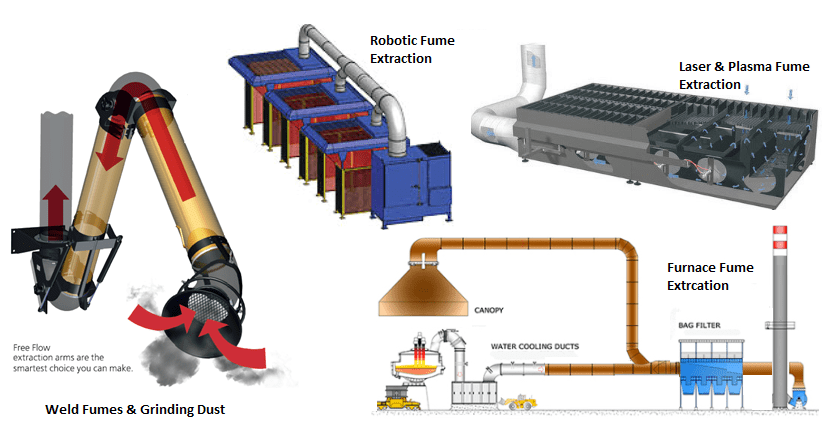
A fume extractor is a system utilizing a fan to pull fumes and particulate into a filtration system cleaning the air of harmful chemicals and particulates. Industrial processes create fumes or particles such as welding, sanding, grinding, spraying, powder filling, and chemical applications. Fume extractors use a variety of filters while some systems, depending upon application, use multiple filters in line. The combination of the powerful fan and high-quality filtration media creates a recirculation air pattern for ductless units. These units take up less space, weigh less, are more energy efficient, and have easy access to change filters.
DUST DISCHARGE EQUIPMENTS
ROTARY AIR LOCK VALVES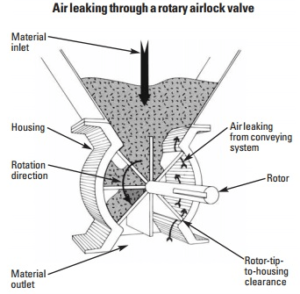
Dust discharge equipments such as rotary valve, pendulum valve and valves with two pendulums are used to take the dust accumulated on the filter bags out of the filter.Dust discharge equipments are selected in the proper size in accordance with the filter capacities.Dust discharge equipments used in empting out the stuff stocked in the silos in controlled way are delivered with the drive units.
SLIDEGATE VALVES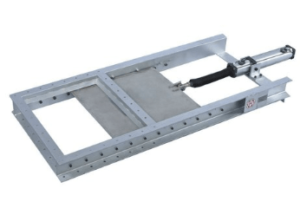
Silo discharge slide gate valves are generally actuated by pneumatic pistons. They are used for opening and closing product flow automatically to discharge the product to downstream equipment. … Slide gate valves can be installed at the inlet and outlet of dry bulk mixers.
ATEX – EXPLOSION PROTECTION GUIDELINES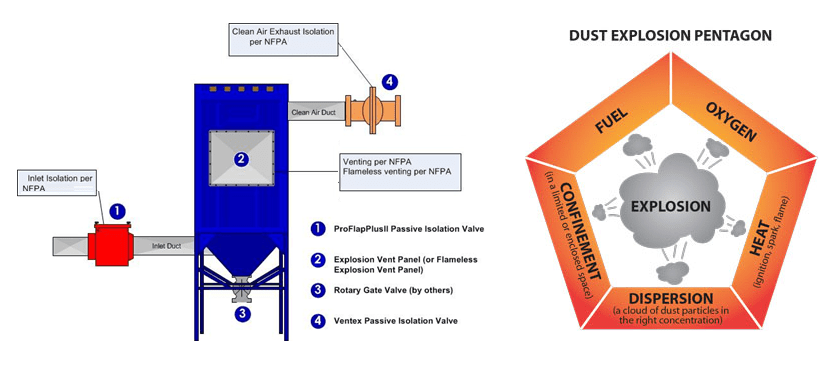
The abbreviation ATEX stands for the French term ATmosphères EXplosibles (explosive atmospheres). An important area of safety technology is protection against explosions. Effective explosion protection should prevent damage to people, machines and systems. Products and equipment in potentially explosive atmospheres in the European Union must comply with the requirements of the ATEX guidelines. Pumps and high-pressure solutions are also subject to these guidelines. Further regulations and certifications exist for use outside the European Union.
Primary, secondary and tertiary explosion protection
The ATEX guidelines define a specific sequence for the various explosion protection measures.
ATEX GUIDELINES
The ATEX Directive comprises the two guidelines 1999/92/EC (Operational Directive) and 2014/34/EU (Product Directive). The ATEX Product Directive 2014/34/EU contains the rules for placing equipment and products on the market in potentially explosive atmospheres. It applies not only to electrical equipment and machines, but also to non-electrical components such as fans, blowers, pumps and high pressure cleaning systems. These can also present ignition hazards due to inadmissible heating. In addition to the main objective of protecting people from explosions and their effects, the guideline is also intended to remove barriers to trade.
The guideline lists various requirements that manufacturers of products must observe. Compliance with the Explosion Protection Guidelines must be demonstrated by means of appropriate conformity assessment procedures. Only devices and components that comply with the ATEX Product Directive may be used in potentially explosive atmospheres. Stationary or mobile machines, operating materials, equipment and control parts as well as protective devices are considered as devices.
ZONE CLASSIFICATION OF POTENTIALLY EXPLOSIVE ATMOSPHERES ACCORDING TO ATEX
Potentially explosive atmospheres are subdivided into different zones depending on the duration and frequency of occurrence of hazardous atmospheres. These zones are: Zone 0, Zone 1, Zone 2, Zone 20, Zone 21 & Zone 22
WORKING PRINCIPAL OF WET SCRUBBERS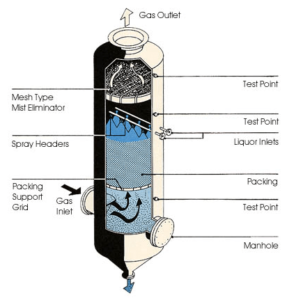
At DEGATECH, we classify scrubbers a number of ways. Wet scrubbers have been used in a variety of industries such as acid plants, fertilizer plants, steel mills, asphalt plants, and large power plants. Small space requirements: Scrubbers reduce the temperature and volume of the unsaturated exhaust stream.
HOW WET SCRUBBERS WORK
Water is the most common solvent used to remove inorganic contaminants. In the most basic form of wet scrubbers, water is encapsulated in a metal or composite container, contaminated gas is moved through the water, the water then absorbs the contaminates, and clean gas exits the scrubber.
Aside from water, other liquids can be used as absorbing solutions to effectively remove varied contaminates. Manipulating the chemical composition of the absorbing solutions changes the overall charge, which can be highly positively charged, negatively charged, or non-charged. Because pollutants differ in their charge, wet scrubbers are packed with the liquid that will bind most effectively to remove the contaminant from the gas.
Wet scrubbers can remove particulate matter by capturing them in liquid droplets. The droplets are then collected, with the liquid dissolving or absorbing the pollutant gases. Any droplets that are in the scrubber inlet gas must be separated from the outlet gas stream using a mist eliminator. Also, the resultant scrubbing liquid must be treated prior to any ultimate discharge or being reused in the plant.
A wet scrubber’s ability to collect particulate matter is often directly proportional to the power input into the scrubber. Additionally, a properly designed and operated mist eliminator is important to achieve high removal efficiencies.
If the gas stream contains both particulate matter and gases, wet scrubbers are generally the only single air pollution control device that can remove both pollutants.
Wet scrubbers that remove gaseous pollutants are referred to as absorbers. Good gas-to-liquid contact is essential to obtain high removal efficiencies in absorbers. Various wet-scrubber designs are used to remove gaseous pollutants, with one of the most popular sub-categories of wet scrubber known as Packed-Bed, Packed-Tower, or “acid gas” (when they are used to control inorganic gases).
VENTURI SCRUBBERS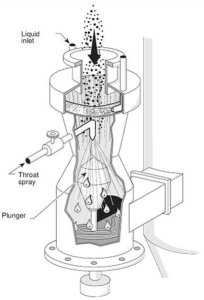
Another popular type of wet scrubber is the Venturi scrubber. Venturis can be used to collect both particulate and gaseous pollutants, but they are more effective in removing particles than gaseous pollutants.
With Venturi scrubbers, the dirty gas entering a scrubber is forced at high velocity through a Venturi where it collides with scrubbing water. The tiny water droplets capture particles through impaction and diffusion. The mist eliminator for a Venturi scrubber is often a separate device called a cyclonic separator. The dirty water is then removed in the cyclonic separator and discharged into a recycle tank. Some of the liquid is continuously purged to limit the solids concentration and allow recirculation back to the Venturi section.
A Venturi scrubber typically consists of three sections:
Converging section – Inlet gas stream enters the converging section and, as the area decreases, gas velocity increases. Liquid is introduced either at the throat or at the entrance to the converging section.
TYPES OF FANS & BLOWERS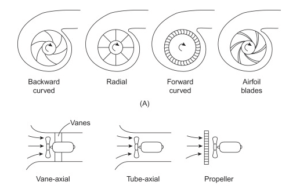
FORWARD CURVED FANS
The forward curved centrifugal fans are also called as ‘squirrel cage’ fans because the wheel type used in this fan is of squirrel cage wheel. The impeller has forward blades which are relatively smaller, curved in direction of wheel rotation.
The delicate construction of the impeller, shaft, bearings, and housing of forward curved fans limit its suitability in industrial applications. These fans are ideal for low speed and low pressure applications such as in domestic furnaces, central station units, packaged air conditioning etc.
BACKWARD INCLINED FANS
The backward inclined centrifugal fans offer three standard blade types – flat single thickness, curved single thickness and curved airfoil. The blades are generally heavier and larger than forward curved and move away from the direction of wheel rotation. They produce relatively medium to high airflow at static pressures.
These fans produce highest operating speeds and are found to be more efficient than the other types of centrifugal fans. The backward inclined fans are typically used in low pressure, high volume applications such as heating, ventilation and air conditioning systems.
RADIAL BLADE FANS
Radial blade centrifugal fans also called as paddle wheel fans, consists of an impeller with multiple equally spaced flat blades that are extending perpendicular to the direction of wheel rotation. The wheel is a paddle type wheel which may or may not contain side rims and the blades are comparatively heavier, deeper and narrower than forward and backward inclined blades.They produce medium to high pressure and moves relatively a higher mass or volume of fluid. Radial blade types are well suited for material handling and in some moderate pressure industrial applications.
AIRFOIL BLADE FANS
Airfoil blade fans have hollow backward inclined blades that are suitable to handle large volumes of clean air at low to moderate static pressures. These fans produce optimum efficiency and run at greater speed than the backward inclined fans.
As they can handle large volumes of air, these fans are extensively used in forced and induced draft fans that are suitable for broad operating ranges in industrial applications, HVAC systems, air pollution control, drying & filtration, and other industrial processes.
RADIAL TIP FANS
The blades of radial tip centrifugal fans have backward curved configuration but cupped in the direction of the wheel rotation. The velocity produced by the Radial tip fan is same as that of backward inclined wheel to move the given mass or volume of air. These fans have compact design than airfoil and backward curved fans and are ideal for high-volume flow rate applications where the pressure requirement is also relatively high.
Radial tip fans have moderate material handling capabilities but are more efficient than radial blade fans. They are generally used in dust collection systems and general ventilation applications.
INLINE CENTRIFUGAL FANS
The inline centrifugal fans have rugged construction with backward inclined type wheels enclosed in a tube-axial casing. These are medium duty fans with straight through airflow.
When compared to radial inclined type fans the inline centrifugal fans are less efficient and are used in low pressure air system requirements like heating and ventilating.
Based on the specific requirements of airflow rate, volume, pressure and efficiency, centrifugal fans of various types are designed to serve the needs of diverse industrial applications.
For more detailed information on any of our product category, please get in touch with DeGATECH technical team or our authorized channel partner in your area.